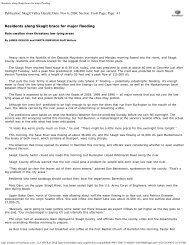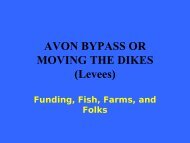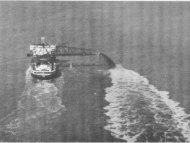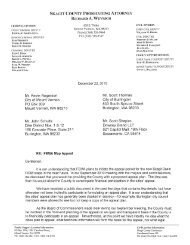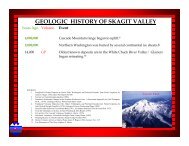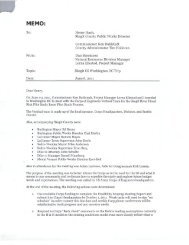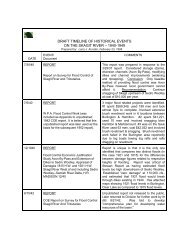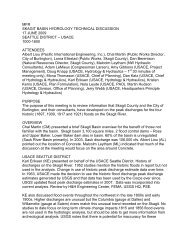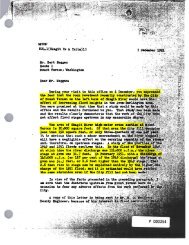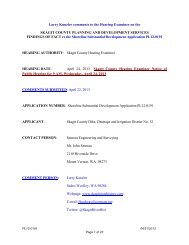Procedures for Compliance with Floodway Regulations.pdf
Procedures for Compliance with Floodway Regulations.pdf
Procedures for Compliance with Floodway Regulations.pdf
Create successful ePaper yourself
Turn your PDF publications into a flip-book with our unique Google optimized e-Paper software.
community officials should be aware of specific applicable requirE'ments in<br />
order to avoid adverse Oood insurance rating.<br />
5-7. Highway Slream Crossing. For communities where the NFIP regulations<br />
are in effect and the regulatory floodway defined, the initial allernalive<br />
analyzed should be a highway stream crossing <strong>with</strong> all components excluded<br />
from the f100dway. The design, which essentially spans the Ooodway, must<br />
also limit the rise of the base flood (l aD-year Oood profile) <strong>with</strong>in the<br />
regulatory criteria (normally one fooU. The alternative must be sufficiently<br />
detailed to show the effect on the Ooodway profile.<br />
When it is clearly shown to be inappropriate to design a highway crossing<br />
to avoid encroachment on the floodway and where the floodway cannot be<br />
modified such that the structure could be excluded, FEMA will approve an<br />
alternate floodway <strong>with</strong> profile in excess of the 1 foot maximum only when<br />
the following conditions have been met:<br />
1. A location hydraulic study has been per<strong>for</strong>med in accordance <strong>with</strong><br />
Federal·Aid Highway Program Manual (FHPM) 6- 7·)·2 ~location and<br />
Hydraulic Design of Encroachments on Floodplains" (23 CFR 650, Subpart A)<br />
and FHWA finds the encroachment is the only practicable alternative (Federal<br />
Highway Administration 1979).<br />
2. The construaing agency has made appropriate arrangements <strong>with</strong><br />
affected property owners and the community to obtain flooding easements or<br />
Olherwise compensate them {or future flood losses due to the effeas of the<br />
structure.<br />
3. The constructing agency has made appropriate arrangements to assure<br />
that the National Flood Insurance Program and Flood Insurance Fund do not<br />
incur any liability f()( additional future flCXld losses to existing structures which<br />
are insured under the Program and grandfathered in under the risk stalUs<br />
existing prior to the construction of the structure.<br />
4. Prior to initiating construction, the constructing agency provides FEMA<br />
<strong>with</strong> revised nood profiles, noodway and floodplain mapping, and background<br />
technical data necessary <strong>for</strong> FEMA to issue revised Flood Insurance<br />
Rate Maps and Flood Boundary and <strong>Floodway</strong> Maps <strong>for</strong> the affeaed area upon<br />
completion of the struaure.<br />
6. <strong>Floodway</strong> Impact Analysis<br />
6-1. General. The developer must assemble and provide to the local<br />
officials in<strong>for</strong>mation and analysis results ofthe effeetsof the proposed development<br />
on fulure flood elevations. These data will be used to determine whether<br />
or not the requeS( f()( floodway development is approved.<br />
6-2. Dala Required. The followingd3t3 mUSf be provided by the developer<br />
(permit applicantJ and submined to the appropriate local officials to use in<br />
determining the effect of the proposed aaivity on future Oood heights.<br />
1. Valley Cross Sections. The valley cross section of the channel and<br />
overbank area must be taken perpendicular to the flow of the stream (see<br />
Figure 7l. The cross seaion must extend to an elevation above the expected<br />
1DO-year floodplain.<br />
NOle: Sections right angle to flow<br />
omit· not effeclive to convey flow<br />
regular intervals<br />
Figure 7:<br />
I<br />
Q)<br />
1<br />
ch3n~e in<br />
cross section<br />



